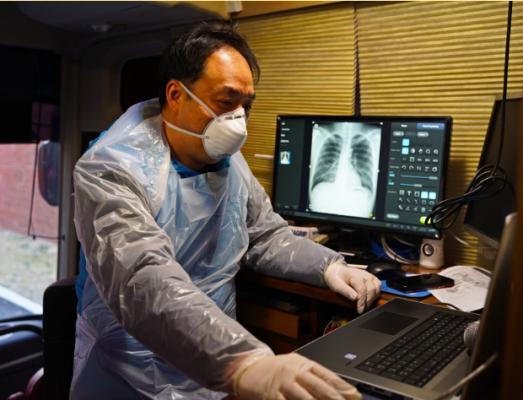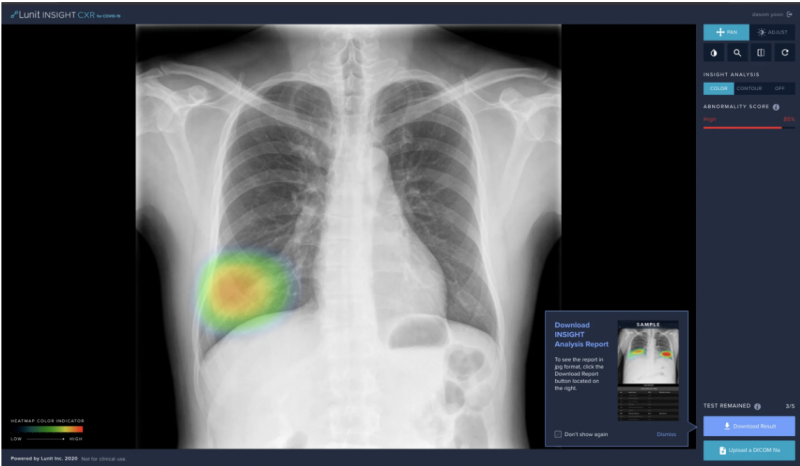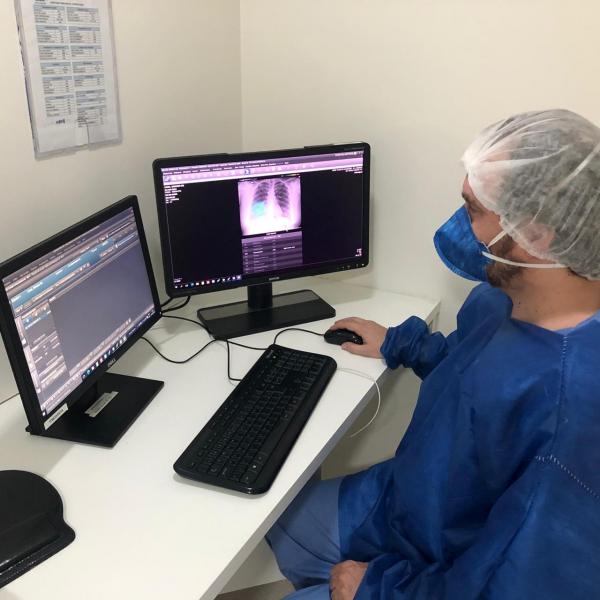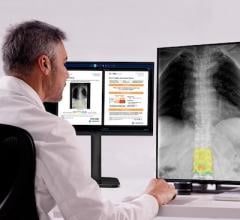
A physician working in a coronavirus care center nearby Daegu, South Korea, is using Lunit INSIGHT CXR to interpret chest X-ray image of a coronavirus patient. Photo by Seoul National University Hospital
March 30, 2020 — Lunit, a medical AI software company that develops AI-powered analysis of lung diseases via chest X-ray images, today announced that it will be releasing its software online, free of charge, to help healthcare professionals manage coronavirus.
Coronavirus is known to cause pneumonia, which can be found as “consolidation” on chest X-ray images. The software, developed by Lunit, is an AI solution for chest X-ray analysis, detecting 10 different radiologic findings including lung nodule, consolidation, and more with 97-99 percent accuracy. For the online release, the company is providing consolidation findings only, which is suggestive of coronavirus-related pneumonia.
“We hope our decision to publicly release a special version of our software can help ease the strain in the healthcare system in countries around the world,” said Brandon Suh, CEO of Lunit. “Our AI solution has been in use at coronavirus care centers in South Korea, which is one of the countries that are successfully “flattening the curve” by applying diverse and innovative measures in the battle against the virus.”
In South Korea, Lunit INSIGHT CXR has been deployed to assist the diagnosis of COVID-19 patients from Daegu and nearby region, the hardest-hit area where approximately 8,000 patients — about 85 percent of the entire domestic cases — has been diagnosed. Seoul National University Hospital has built a coronavirus care center in Daegu, where physicians remotely examine patients via video call.
The patients’ chest X-ray images are sent directly to radiologists in Seoul, where Lunit INSIGHT CXR is used to support the radiologists in the management of COVID-19. The system helps healthcare professionals in the prompt and early discovery of patients, sending them directly to larger hospitals for proper treatment if required.
Beyond South Korea, Lunit INSIGHT CXR has also been installed at PreventSenior, one of the largest hospital networks in Brazil with 8 locations throughout the metropolitan region of Sao Paulo. PreventSenior is one of the COVID-19 detection centers that use chest x-ray screening for patients with mild symptoms.
In March, PreventSenior has deployed Lunit INSIGHT CXR for the analysis of more than 3,000 chest x-ray images suspected of coronavirus infection. The doctors at PreventSenior says that Lunit INSIGHT CXR is providing great help “especially for patient triage,” as the hospital is “overflowing with patients while the number of radiologists remains low.”
Physicians and radiologists working at Lunit suggest that the AI may be used as a supportive tool during case overload, which can likely lead to low reading quality, or with portable x-ray devices to fast-track test results and decision-making in advance to the PCR results, which is the test for a definitive diagnosis for coronavirus.
Lunit INSIGHT CXR can also assist when regular monitoring is required for patients showing mild symptoms, in order to identify and triage patients by the progression and regression of symptoms.
“The current coronavirus epidemic is burdening health care providers around the world with massive demands for tests, diagnosis, and treatment,” said Ki Hwan Kim, Chief Medical Officer of Lunit. “While PCR is used to make a definitive diagnosis for coronavirus, chest X-ray can also be a fast, effective, and affordable test to evaluate coronavirus-related pneumonia, but the massive shortage of interpreting radiologists exists as a hurdle. AI can provide assistance.”
According to Lunit’s recent internal study, Lunit INSIGHT CXR is able to detect coronavirus pneumonia in the level of radiologists. In the study, anteroposterior chest X-rays (CXRs) of 6 patients confirmed to have coronavirus disease-19 (COVID-19) at the time of admission were retrospectively analyzed by Lunit INSIGHT CXR. Both radiologists and AI correctly detected CXR abnormalities from X-ray images of three patients with clearly visible lesions. Neither radiologist nor AI was able to detect subtle or non-visible lesions from the other three patients.
“The AI can instantly interpret chest x-ray images to select suspicious cases that warrant further action to whether or not isolate the patient even before PCR confirmation,” said Kim. “Lunit INSIGHT CXR may be beneficial especially as a triage tool for non-radiologists, or even for non-doctors in extreme cases.”
In light of the current outbreak, Lunit has released a special version of Lunit INSIGHT CXR specific for coronavirus, at www.lunit.io/covid19. Anyone can upload chest x-ray DICOM image files and get real-time analysis results conducted by Lunit INSIGHT, for free, with coronavirus-related findings displayed by the algorithm as “consolidation.”
For more information: www.lunit.io/en/covid19
Related Coronavirus Content:
VIDEO: Use of Telemedicine in Medical Imaging During COVID-19
VIDEO: How China Leveraged Health IT to Combat COVID-19
CDRH Issues Letter to Industry on COVID-19
Qure.ai Launches Solutions to Help Tackle COVID19
ASRT Deploys COVID-19 Resources for Educational Programs
Study Looks at CT Findings of COVID-19 Through Recovery
VIDEO: Imaging COVID-19 With Point-of-Care Ultrasound (POCUS)
The Cardiac Implications of Novel Coronavirus
CT Provides Best Diagnosis for Novel Coronavirus (COVID-19)
Radiology Lessons for Coronavirus From the SARS and MERS Epidemics
Deployment of Health IT in China’s Fight Against the COVID-19 Epidemic
Emerging Technologies Proving Value in Chinese Coronavirus Fight
Radiologists Describe Coronavirus CT Imaging Features
Coronavirus Update from the FDA
CT Imaging of the 2019 Novel Coronavirus (2019-nCoV) Pneumonia
CT Imaging Features of 2019 Novel Coronavirus (2019-nCoV)
Chest CT Findings of Patients Infected With Novel Coronavirus 2019-nCoV Pneumonia




 December 24, 2025
December 24, 2025 









